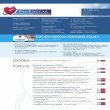This record has been created in order to evaluate the results of percutaneous aortic valve replacement in the UK and currently includes more than 4500 patients with 100% follow-up for mortality. The 3-year mortality was 61.6 % beyond the device or path. Atrial fibrillation, renal failure, chronic obstructive pulmonary disease and a EuroSCORE > 18.5<a href="https://solaci.org/en/2015/06/24/uk-tavi-registry-long-term-results-of-tavi-in-the-uk/" title="Read more" >...</a>
Clinical results of TAVI in Asia
Since all the studies available in the literature were conducted in North America or Europe, the results of percutaneous aortic valve replacement in Asia are unknown. We included 253 patients with severe aortic stenosis who received TAVI at 14 sites in Asia (Edwards Sapiens: 140 patients; Medtronic Core Valve: 113 patients). The success rate was<a href="https://solaci.org/en/2015/06/24/clinical-results-of-tavi-in-asia/" title="Read more" >...</a>
REPRISE II: results obtained with the new valve according to VARC criteria
The objective was to evaluate the safety and efficacy of the Lotus Valve System to treat patients with severe aortic stenosis and high surgical risk. The study included 60 patients who received the device and were followed during 30 days. Mortality from all causes was 1.7% and the incidence of stroke was 8.6%, with half<a href="https://solaci.org/en/2015/06/24/reprise-ii-results-obtained-with-the-new-valve-according-to-varc-criteria/" title="Read more" >...</a>
JUPITER: transapical TAVI device
We evaluated 88 consecutive patients (at this phase) with severe aortic stenosis who received the second-generation device for transapical access. Survival at thirty days was 85.1% with a cardiovascular death rate of 4.8%. No strokes were observed during this period. Average gradient reduction was highly significant, (40.4 to 8.1 mmHg, p <0.001), as well as<a href="https://solaci.org/en/2015/06/24/jupiter-transapical-tavi-device/" title="Read more" >...</a>
DISCOVER: new low profile valve with little post-implant regurgitation
The objective of the study was to assess events after 30 days with the DirectFLOW Medical Valve device in patients with severe aortic stenosis and high surgical risk. The device is designed to reduce post-implant aortic regurgitation; it has a low profile and high navigability and requires no post-dilatation or rapid pacing. The study included<a href="https://solaci.org/en/2015/06/24/discover-new-low-profile-valve-with-little-post-implant-regurgitation/" title="Read more" >...</a>
Educational Journal N° 97
SINDROME CORONARIO AGUDO • Infarto Agudo de Miocardio: Nuevo Paradigma en el tratamiento de STEMI – Dr. Luis Guzmán • Nuevas estrategias de reperfusión miocárdica en el Infarto Agudo de Miocardio con Elevación del Segmento ST – Dr. José Armando Mangione ANGIOPLASTIA TRANSLUMINAL CORONARIA EN SITUACIONES ESPECIALES • ¿Cuál es la mejor estrategia en las bifurcaciones? – Dr.<a href="https://solaci.org/en/2015/05/19/educational-journal-n-97/" title="Read more" >...</a>
Frequency, indication and evolution of emergency cardiac surgery during TAVI
Original Title: Emergent cardiac surgery during transcatheter aortic valve implantation (TAVI): insight the Edwards SAPIENS Aortic Bioprosthesis Outcome (SOURCE) registry. Reference: Holger Eggerbrecht, et al. EuroIntervention 2014;10:975-81 SOURCE register data from patients receiving transcatheter aortic valve implantation with the Edwards Sapiens valve, were analyzed; out of 2307 patients, 27 (1.2%) required emergency cardiac surgery (ECS). Valve stenosis was<a href="https://solaci.org/en/2015/01/16/frequency-indication-and-evolution-of-emergency-cardiac-surgery-during-tavi/" title="Read more" >...</a>
TAVR: Regression of Left Ventricular Hypertrophy Decreases Re-hospitalization
Original title: Early Regression of Severe Left Ventricular Hypertrophy After Transcatheter Aortic Valve Replacement Is Associated with Decreased Hospitalization. Reference: Brian Lindman, et al. JACC Cardiovasc Interv 2014;7:662-73. Left ventricular hypertrophy, defined by the increase of left ventricular mass, has long been associated to increased morbi-mortality in the context of different heart conditions. LV hypertrophy regression might<a href="https://solaci.org/en/2014/08/05/tavr-regression-of-left-ventricular-hypertrophy-decreases-re-hospitalization/" title="Read more" >...</a>
Prognostic factors for early mortality in patients undergoing TAVI; Individual risk calculation using a simple score: Derivative analysis from FRANCE II Registry.
Original title: Predictive factors of early mortality after transcatheter aortic valve implantation: individual risk assessment using a simple escore. Reference: Heart. 2014 Apr 16. doi: 10.1136/heartjnl-2013-305314. Epub ahead of print. The decision to perform an intervention in symptomatic aortic stenosis must balance surgery or transcatheter aortic valve implantation (TAVI) risk. Factors associated with early mortality after TAVI<a href="https://solaci.org/en/2014/04/30/prognostic-factors-for-early-mortality-in-patients-undergoing-tavi-individual-risk-calculation-using-a-simple-score-derivative-analysis-from-france-ii-registry/" title="Read more" >...</a>
Low flow impact on outcomes following TAVI should be taken into account
Original title: Impact of Low Flow on the Outcome of High-Risk Patients Undergoing Transcatheter Aortic Valve Replacement. Reference: Florent Le Ven, et al. J Am Coll Cardiol 62;9:792-788 A study of low flow (SVi <35ml/m2) in the context of severe aortic stenosis has shown it is a predictor of worse outcomes after surgery, even though evolution with medical<a href="https://solaci.org/en/2013/08/26/low-flow-impact-on-outcomes-following-tavi-should-be-taken-into-account/" title="Read more" >...</a>









